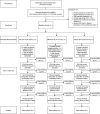Scaling-up high-impact micronutrient supplementation interventions to improve adolescents' nutrition and health in Burkina Faso and Tanzania: protocol for a cluster-randomised controlled trial
- PMID: 36792333
- PMCID: PMC9933747
- DOI: 10.1136/bmjopen-2022-063686
Scaling-up high-impact micronutrient supplementation interventions to improve adolescents' nutrition and health in Burkina Faso and Tanzania: protocol for a cluster-randomised controlled trial
Abstract
Introduction: Adolescence is a critical time for growth and development, but this age group is often neglected in research and development of nutrition interventions. Despite recommendations from the WHO to provide nutrient supplements to adolescents, evidence remains scarce on the most effective supplementation strategy. This study aims to compare weekly iron and folic acid (IFA) supplementation with daily multiple micronutrient supplements (MMSs) in prevention of anaemia and improvement of school outcomes among adolescents in Burkina Faso and Tanzania.
Methods and analysis: A three-arm cluster-randomised, school-based supplementation trial will be conducted among 84 schools (42 schools per site) and roughly 4500 students aged 10-17. Schools will be matched on three characteristics: number of students, school ranking profile, distance to main road (Tanzania) or distance to city council (Burkina Faso). Each school will be randomised to receive either weekly IFA, daily MMSs or serve as a control. Supplements will be delivered to students by teachers, who will provide monitoring data to the study team. Baseline and endline surveys will be conducted prior to and after each supplementation cycle (12 weeks in Burkina Faso; 1 year in Tanzania) to assess haemoglobin, anthropometry and sociodemographic variables. The primary outcome of haemoglobin will be analysed continuously using linear regression, and anaemia status will be analysed using logistic or multinomial regression, depending on categorisation level of the outcome. Secondary analyses of school performance indicators will also be conducted with either logistic or linear regression.
Ethics and dissemination: This protocol has been approved by the Institutional Review Board of the Harvard TH Chan School of Public Health (IRB20-1108) and the Research Ethics Committees for the Ministries of Health in Tanzania (Zanzibar) and Burkina Faso. Results will be disseminated during meetings with the Ministries of Health and the participating communities as well as through peer-reviewed publications.
Trial registration number: NCT04657640; NCT05104554.
Keywords: anaemia; community child health; nutrition; public health.
© Author(s) (or their employer(s)) 2023. Re-use permitted under CC BY-NC. No commercial re-use. See rights and permissions. Published by BMJ.
Conflict of interest statement
Competing interests: All authors have completed the ICMJE uniform disclosure form at http://www.icmje.org/disclosure-of-interest/ and declare that all authors had financial support from an anonymous donor for the submitted work and received donation of multiple micronutrient supplements from Kirk Humanitarian; no financial relationships with any organisations that might have an interest in the submitted work in the previous 3 years; no other relationships or activities that could appear to have influenced the submitted work.
Figures
References
-
- UNICEF . Adolescent health: the missing population in universal health coverage. 2018.
-
- Adolescent Demographics . UNICEF DATA. 2022. Available: https://data.unicef.org/topic/adolescents/demographics/(accessed
-
- Ramakrishnan U. Nutritional anemia. Boca Raton, FL, 2001.
-
- Bundy DAP, Silva N, Horton S, et al. Re-imagining school feeding: A high-return investment in human capital and local economies. Washington, D.C: World Bank, 2018.
Publication types
MeSH terms
Substances
Associated data
LinkOut - more resources
Full Text Sources
Medical

